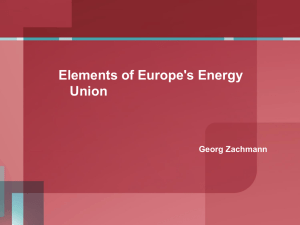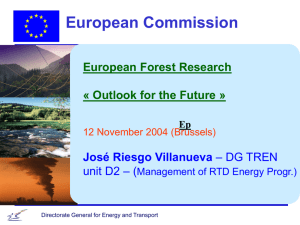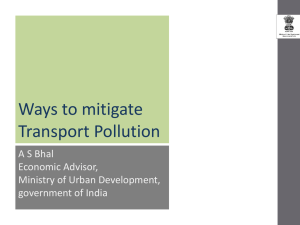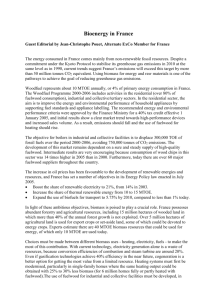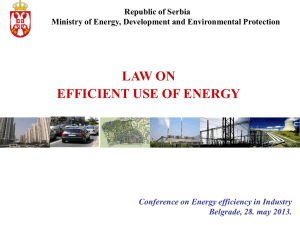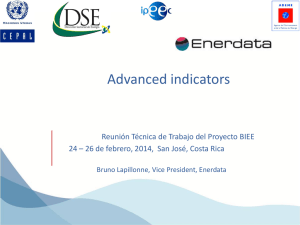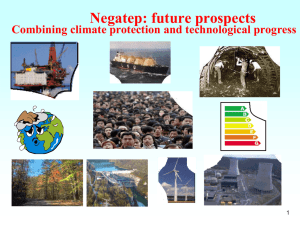POLICY EUROPEAN
advertisement
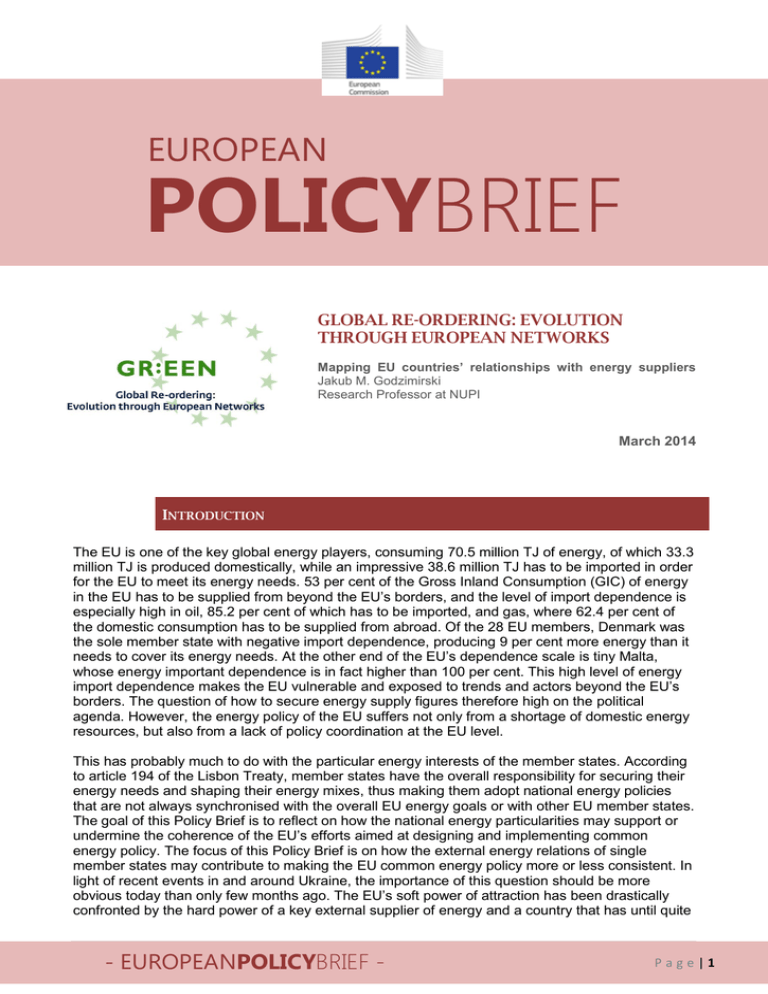
EUROPEAN POLICYBRIEF GLOBAL RE-ORDERING: EVOLUTION THROUGH EUROPEAN NETWORKS Mapping EU countries’ relationships with energy suppliers Jakub M. Godzimirski Research Professor at NUPI March 2014 INTRODUCTION The EU is one of the key global energy players, consuming 70.5 million TJ of energy, of which 33.3 million TJ is produced domestically, while an impressive 38.6 million TJ has to be imported in order for the EU to meet its energy needs. 53 per cent of the Gross Inland Consumption (GIC) of energy in the EU has to be supplied from beyond the EU’s borders, and the level of import dependence is especially high in oil, 85.2 per cent of which has to be imported, and gas, where 62.4 per cent of the domestic consumption has to be supplied from abroad. Of the 28 EU members, Denmark was the sole member state with negative import dependence, producing 9 per cent more energy than it needs to cover its energy needs. At the other end of the EU’s dependence scale is tiny Malta, whose energy important dependence is in fact higher than 100 per cent. This high level of energy import dependence makes the EU vulnerable and exposed to trends and actors beyond the EU’s borders. The question of how to secure energy supply figures therefore high on the political agenda. However, the energy policy of the EU suffers not only from a shortage of domestic energy resources, but also from a lack of policy coordination at the EU level. This has probably much to do with the particular energy interests of the member states. According to article 194 of the Lisbon Treaty, member states have the overall responsibility for securing their energy needs and shaping their energy mixes, thus making them adopt national energy policies that are not always synchronised with the overall EU energy goals or with other EU member states. The goal of this Policy Brief is to reflect on how the national energy particularities may support or undermine the coherence of the EU’s efforts aimed at designing and implementing common energy policy. The focus of this Policy Brief is on how the external energy relations of single member states may contribute to making the EU common energy policy more or less consistent. In light of recent events in and around Ukraine, the importance of this question should be more obvious today than only few months ago. The EU’s soft power of attraction has been drastically confronted by the hard power of a key external supplier of energy and a country that has until quite - EUROPEANPOLICYBRIEF - Page|1 recently been described as the EU’s strategic partner. The fact that the conflict also involves one of the main transit countries only exacerbates the situation. GEOGRAPHICAL ENERGY CLUSTERS IN THE EU The EU energy strategy aims at achieving and balancing three main goals: secure the supply of energy, build a sustainable energy system and make sure that the energy use in the EU does not considerably worsen the EU’s economic competitiveness. This EU trilemma could have been easily solved had the EU been self-sufficient in energy terms and had the energy resources within the EU been of the most sustainable character and reasonably priced. Ideally, the EU should be completely energy self-sufficient and the energy at its disposal should be cheap and should not have any negative impact on the local and global environment and climate. However, current energy realities challenge the EU on all those three fronts. The EU has to import energy in order to meet its energy needs, the energy commodities that the EU has to import are expensive and the impact of the energy use on the environment seems to be more detrimental than expected. To add to this already challenging situation, the EU has to import most of its energy from areas that are relatively risky in political terms, the EU’s energy import dependence will most probably increase rather than decrease in the years to come, and the EU’s environmental ‘energy footprint’ will probably remain rather strong, all pro-environmental efforts notwithstanding. The way the EU’s common energy policy is designed and implemented depends on a number of political, economic, social, geographical and geopolitical factors. Today’s EU common energy policy has three key elements –to improve the competitiveness of the EU economy, which faces increasing competition from other global centres of economic power; to be sustainable, which means to help the EU make a positive contribution to the global fight against climate change; and last, but not least, to secure supplies of energy from beyond the EU’s borders, making energy policy an important element of the EU’s external relations. This last element of the EU common energy policy has quite recently been dramatically actualized by the military conflict at the EU’s eastern doorstep, which involves the main external supplier of energy to the EU and the most important transit country through which more than half of the Europe destined Russian gas has to pass. However, the EU’s ability to cope with energy challenges is influenced not only by external factors but also by the energy policies and priorities of member states. As all member states, except for Denmark, consume more energy than they produce, they are dependent on energy supplies coming from beyond their borders. Their energy choices are therefore influenced by the energy relations they have managed to build with their external energy suppliers. Relations with the external energy suppliers may vary over time and may also influence relations among the member states, as member states may either cooperate or compete when realizing their national energy policies in the global and regional energy market. The influence single EU member states may exert on energy policies of the main energy suppliers – and on the common EU energy policy – may also vary according to the size of their energy markets, the volume of their energy imports, their overall bilateral relations and their political capacity to influence processes and decisions in the EU. Resources, geography and size matter Four factors shape the EU’s external energy relations in the most decisive manner. The first one is the availability of energy resources within the Union. The second is the availability of resources and infrastructure in the vicinity of the EU’s external borders. The third factor is the size of energy markets in the EU and in single member states giving them market power they can use when dealing with external energy suppliers, but also making them less or more vulnerable to external energy influences. The fourth factor is energy policy choices and priorities made by national and European decision-makers. - EUROPEANPOLICYBRIEF - Page|2 The first factor is structural and the EU has relatively limited power to change it. The second factor is partly structural (geology) and partly a result of political and economic decisions on the development of energy infrastructure, like the decision on the construction of gas infrastructure linking gas fields in the Western Siberia with the European gas market. The size of the energy market can also be described as a structural factor that has to do with historical developments, but the composition of the energy mix is at least partly a result of political decisions, like in the case of the German energiwende program that aims to make the German energy mix greener. The fourth factor is of political character and political decisions can indeed change its parameters, for instance through the process of experimentalist governance that could result in the revision of goals, metrics and decision-making procedures through a process involving central and local units. Who depends on whom? There is a huge variation in terms of energy import dependence in the EU. The EU as a whole has to import 53 per cent of energy, but Denmark exports almost 10 per cent more energy than it consumes, while Malta has to import 100 of its energy. The size of the national energy markets is also an important factor – the EU’s GIC reached 1699 mtoe in 2011 with Germany as the biggest market with an energy consumption of 317 mtoe – of which 61.2 per cent has to be imported – and Malta consuming 0.932 mtoe of energy. In order to present who depends on whom in energy terms the focus will be on two aspects of that dependence – the geography of energy relationships and the grade of dependence. The grade of dependence is measured by dividing energy relationships in five categories – strategic relationships with imports exceeding 10 mtoe; important relationships with imports between 5 and 10 mtoe; less important relationships with imports between 1 and 5 mtoe; and marginal relationships with volume of imports lower than 1 mtoe. The EU countries that are not listed in the overview of the energy relationships below do not import energy from the given source and belong to the fifth category – those with no energy relation whatsoever. The countries listed in this overview of energy relationships are listed in descending order, starting with most important energy customers. The data presented here stems from the overview of the energy imports for 2011, the last year with the complete overview available in the Eurostat database. Russia is the most important external energy supplier to the EU. In 2011 it supplied the EU with 177 mtoe of oil, 107 mtoe of natural gas and 52.7 mtoe of coal. This represented 19.82 per cent of the gross inland consumption (GIC) of energy in the EU and 23.4 per cent of the total import of energy to the EU. Germany, Poland, Netherlands, Belgium and Italy imported more than 10 mtoe of Russian oil in 2011and those relationships are of strategic character; Finland, Sweden, France, Lithuania, Spain, Slovakia and Hungary are important importers importing between 5 and 10 mtoe; Bulgaria, United Kingdom, Greece, Czech Republic, Croatia, Romania and Austria imported between 1 and 5 milion mtoe and belong to the category of less important oil partners, while the volumes of oil import of Portugal, Denmark and Estonia were higher than 0 but lower than 1 mtoe making them marginal importers. In gas the situation is as follows: Germany and Italy imported more than 10 mtoe; Poland, the Czech Republic, the UK, Austria, France and Slovakia more than 5 but less than 10 mtoe; Hungary Finland, Lithuania, Greece, Bulgaria, Romania, Netherlands and Latvia belonged to the category of less important importers of Russian gas with imports between 1 and 5 mtoe, Estonia, Slovenia, Luxembourg and Belgium are marginal importers of Russian gas (less than 1 mtoe), and the rest of the EU members do not import gas from Russia at all. Coal is the third energy commodity Russia exports to Europe, covering 22.7 per cent of EU’s coal import needs. The United Kingdom and Germany are the most important importers (more than 10 mtoe in 2011), followed by Poland and Finland (more than 5 mtoe), Netherlands, France, Spain, Denmark, Italy and Slovakia (between 1 and 5 mtoe) and Bulgaria, Sweden, Czech Republic, Romania, Lithuania, Latvia, Hungary, Greece, Belgium, Estonia, Portugal and Slovenia importing less than 1 mtoe of Russian coal. Norway is the second biggest external supplier of energy to Europe, supplying 9.16 per cent of Europe’s GIC and 10.8 per cent of energy imports. The 92 mtoe of gas reaching the EU market - EUROPEANPOLICYBRIEF - Page|3 makes it the most important Norwegian energy commodity. Germany, the UK, France and the Netherlands receive more than 10 mtoe of Norwegian gas, making them strategic partners. Belgium receives more than 5 mtoe and thus belongs to the category of important gas partners, Italy, the Czech Republic, Spain and Austria are less important gas partners with supplies bigger than 1 and lower than 5 mtoe while Luxemburg is a marginal receiver of Norwegian gas. Oil is the second most important energy commodity. In 2011 Norway exported 63.6 mtoe of oil to the European market. The UK was the sole country receiving more than 10 mtoe of Norwegian oil; it was followed by a group of three important oil partner countries – Germany, France and the Netherlands – each receiving more than 5 mtoe; by seven less important oil partners – Sweden, Belgium, Denmark, Ireland, Poland, Finland and Italy; and by three countries – Spain, Portugal and Austria as marginal oil partners (less than 1 mtoe). Algeria is ranked the third external supplier of energy to the EU, supplying in 2011 42 mtoe of gas and 13.1 mtoe of oil. The 55.1 mtoe represent 3.24 per cent of the EU’s GIC and 3.83 per cent of energy imports. Italy and Spain receive more than 10 mtoe of gas from Algeria, France less than 10 but more than 5 mtoe, Portugal more than 1 mtoe and Greece, the UK, and Slovenia are marginal receivers of the Algerian gas buying less than 1 mtoe. Austria, the Netherlands, Slovenia and Greece belong to the category of important oil customers buying more than 5 but less than 10 mtoe of oil, while Denmark, Italy, Lithuania, Slovakia, Malta, Germany, Portugal, France, and the UK buy between 1 and 5 mtoe and are less important oil partners. Columbia supplied 48.2 mtoe of coal to the EU making it the fourth external supplier of energy. The Netherlands and Germany imported more than 10 mtoe of coal, the UK more than 5 but less than 10 mtoe, while a group of six countries (Spain, France, Portugal, Denmark, Ireland and Italy) were less important buying more than 1 but less than 5 mtoe of coal from Colombia. Nine countries – Croatia, Belgium, Poland, Greece, Finland, Hungary, Romania, Austria and Sweden – played a marginal part in the Colombian coal landscape (less than 1 mtoe). Nigeria supplies 31.1 mtoe of oil and 14 mtoe of gas, making it the fifth supplier of energy to the EU (2.65 per cent of GIC and 3.13 per cent of the EU’s energy imports). Spain and Germany belong to the category of important oil buyers, France, Netherlands, United Kingdom, Italy, Austria, Portugal and Belgium are less important oil partners (between 1 and 5 mtoe) while Ireland and Greece are marginal (less than 1 mtoe of oil). In gas, Spain is the sole important partner (5–10 mtoe), France, Portugal and the UK are less important partners while Greece is a marginal partner. Saudi Arabia supplied 41.1 mtoe of oil in 2011. Italy, Spain, France, Belgium and the Netherlands all bought less than 10 but more than 5 mtoe of Saudi oil; Greece, Portugal and Germany bought more than 1 but less than 5 while Austria and the UK are to be treated as marginal oil partners of Saudi Arabia, importing less than 1 mtoe. USA supplied 36.7 mtoe of cheap coal, with the United Kingdom and Italy buying more than 5 mtoe (but less than 10 mtoe), followed by the Netherlands, France, Belgium, Spain, Poland and Hungary (more than 1 mtoe) and nine marginal partners (Austria, Portugal, Sweden, Slovakia, Finland, Croatia, the Czech Republic, Denmark and Latvia) Qatar supplied 35 mtoe of natural gas. The UK was the sole strategic partner (more than 10 mtoe) and Italy – the sole important partner. Spain, France and Belgium bought more than 1 mtoe of Qatari gas, while Greece was a marginal partner buying less than 1 mtoe. Iran, selling 29.5 mtoe of oil, was the ninth external supplier of energy to the EU. Italy, Spain and Greece were important oil partners, France and Belgium belonged to the category of less important partners, while Germany, Netherlands, Czech Republic and Poland were marginal (< 1 mtoe each). Kazakhstan exported 29.2 mtoe of oil in 2011. France and Germany were its important partners, Romania, Italy, Austria, the Netherlands and Portugal were less important while the Czech - EUROPEANPOLICYBRIEF - Page|4 Republic, Spain, Greece, Bulgaria and Finland were marginal partners buying less than 1 mtoe of the Kazakh oil. Azerbaijan supplied 25.3 mtoe of oil and has an ambition to become an important gas supplier to Europe. Italy is the sole strategic partner, followed by France buying more than 5 mtoe of Azeri oil, and Germany and the Czech Republic as less important partners. Seven countries – Croatia, Portugal, Spain, Greece, Austria, the UK and Romania are marginal Azeri oil buyers, buying less than 1 mtoe of Azeri oil. Iraq sold 18.2 mtoe of oil in the EU marked in 2011. Italy was an important partner, followed by Spain, the Netherlands, Greece and France as less important ones, and with Belgium, Austria, Germany and Romania as marginal buyers of the Iraqi oil. Australia with its 17.8 mtoe of coal export made an important contribution to the EU’s energy supply, spreading its supplies among Germany, the UK, France, Spain, Italy, Belgium and Sweden (between 1 and 5 mtoe), and the Netherlands, Finland, Poland, Austria and Cyprus buying less than 1 mtoe each. Libya, exporting 14.2 mtoe of oil and 2 mtoe of gas to Europe, was in a special situation in 2011 due to the internal conflict and external intervention that put an end to Gaddafi’s regime in the country. Between 2005 and 2010 Libya exported approximately 50 mtoe of oil and 9 mtoe of gas to Europe and one should therefore expect that political stabilization in that country will result in much higher energy exports to the European energy market, making Libya again one of the four key energy exporters to the EU. In 2011 Italy, France, Germany and Spain bought more than 1 but less than 5 mtoe of Libyan oil, the UK, Greece, Austria, the Netherlands and Ireland less than 1 mtoe each. In gas, Italy bought more than 1 mtoe while Spain bought less than 1 mtoe. It should be, however, expected that Libyan exports of oil and gas will increase once the political situation is under control. South Africa sold 15.9 mtoe of coal to the EU. Italy, Spain, Germany, France, the Netherlands and Denmark were among less important partners (between 1 and 5 mtoe) while Belgium, the UK, Romania, Luxembourg and Ireland were South Africa’s marginal coal customers. Angola played an important part as a supplier of oil to Europe, selling 10.9 mtoe in 2011. No country bought more than 5 mtoe of Angolan oil; five countries – Italy, France, Portugal, Germany and the Netherlands – belonged to the category of less important oil buyers (>1 mtoe) and three – Spain, the UK and Belgium – bought less than 1 mtoe. Indonesia has become an important coal exporter selling 10.2 mtoe of coal to the EU in 2011. Italy bough more than 5 mtoe, Spain more than 1 mtoe, while Slovenia and Hungary were marginal coal customers (less than 1 mtoe). Mexico sold 7.2 mtoe of oil to the EU in 2011. Spain was an important oil customer buying more than 5 mtoe, while the rest – Germany, Portugal, Belgium, the Netherlands and Italy belonged to the category of marginal oil partners, buying less than 1 mtoe. Ukraine, a country in the centre of the ongoing crisis, sold 4.6 mtoe of its coals in the EU energy market. Bulgaria was the sole EU member state buying more than 1 MTOE of coal from Ukraine, while the rest of the Ukrainian coal reached Poland, Romania, Spain, Slovakia, France, Germany, Italy, Sweden, Croatia, Lithuania, Portugal, Finland, the Netherlands, Latvia and Austria, each of them buying much less than 1 mtoe. Venezuela, the country with the biggest oil reserves in the world, exported only 4.6 mtoe of oil to the EU in 2011. Germany bought more than 1 mtoe, while Sweden, the UK, Belgium, the Netherlands, Spain and France were marginal oil customers (<1 mtoe). Kuwait sold 4 mtoe of its oil to customers in the EU. The Netherlands, buying more than 1 mtoe, was the main buyer, while Germany bought less than 1 mtoe. - EUROPEANPOLICYBRIEF - Page|5 Brazil, selling 3.6 mtoe of oil, had one less important oil customer (more than 1 mtoe) which was Portugal, and a group of marginal oil partners, made up of six countries – France, Spain, Germany, the Netherlands, United Kingdom and Belgium. The overview of the energy relationships between the EU’s most important energy suppliers and single EU countries presented above shows clearly who depends on whom in energy terms in today’s Europe. This overview serves also as a point of departure for our policy recommendations presented below. POLICY IMPLICATIONS AND RECOMMENDATIONS Although the EU has embarked on various policies aiming, amongst other goals, to reduce its energy import dependence, the EU as a whole and all current EU member states will remain dependent on energy imports from areas beyond its borders. In order to cope with this challenge the EU has to design and implement strategies that will reduce strategic risks bound to this energy import dependence. These strategies should aim at addressing two types of challenges –EU internal challenges and challenges linked to the EU’s energy relations with the main energy exporting countries that will continue to supply energy to the EU. Coping with internal EU challenges Internal EU challenges are of distinctive character. Some of the challenges can be addressed by adopting purely technical measures while others will require measures that involve not only technological know-how but also political will and additional investments. The EU can and should change the pattern of energy use, increase the role and share of domestically available sustainable energy sources and reduce its energy consumption and footprint. However, one should also give more consideration to the use of conventional and unconventional fossil fuels, first and foremost various forms of natural gas, in the EU in the transition period, as recommended amongst other points in the Making the Green Journey Work study prepared by the European Gas Advocacy Forum and by some European governments that managed in December 2013 to form a coalition in support of a less restrictive approach to the development of shale gas resources in Europe. The EU should focus more on the development of technologies that would reduce the environmental footprint of fossil fuels, such as CCS or clean coal technologies. The EU should further develop a technical infrastructure and legal framework to make the internal energy market function in a way that will reduce the risk of energy shortages in even the most remote parts of the Union. This would require huge investments in infrastructure, such as the construction of new LNG terminals and upgrading of existing terminals and the development of various types of power generation facilities, including thermal, nuclear, hydro, solar and wind power plants on the territory of the EU. The EU and member states should also invest more in building new and upgrading existing oil, gas and electricity grids and in adding new interconnectors and reverse capacity to make the whole internal energy market more flexible and prepared to meet future energy challenges. A good illustration of the long-term impact this approach could have is the fact that the newly added reverse capacity allowed Ukraine to import 2.1 bcm of Russian gas via Slovakia in 2013 and by 2015 Ukraine could get as much as 10 bcm that way. In order to make the process of this structural change smoother the EU should encourage energy cooperation on the regional level by creating the proper conditions for the construction of several functioning regional energy markets that in the next phase could be connected with and transformed into the Pan-European internal energy market. This would be completely in line with recommendations given in a strategy paper published in 2005 in which the European Commission for the first time mentioned the development of regional markets as a step towards a panEuropean market. - EUROPEANPOLICYBRIEF - Page|6 In addition to these technical solutions, the EU should also reconsider its approach to the political dimension of common energy policy. The common energy policy as practiced by both the EU and the national governments lacks the important elements of coherence, efficiency and solidarity. This has made it easier for some external actors to undermine the coherence and efficiency of the common energy policy, as they have chosen to pursue the bilateral track and to play EU member states against each other. In order for the EU to deal with the external challenges to its energy security and policy it is therefore crucial to make the EU energy policy common not only in declaratory but also in practical terms. The recent ‘return of history’ in the EU’s close neighbourhood may have a sobering effect but what is needed is the political will to make it happen. The EU can no longer act as a liberal actor in the realist world in a situation when its vital political, normative and economic interests are at stake. It is time for the EU to use its soft power and market power to promote its common energy interests, even in a situation when this may cause some tensions and practical problems and may incur additional costs. Coping with external challenges When dealing with external actors who play an important part in making the EU meet its energy needs the strategies to be adopted should focus on changing the EU’s energy relations with those energy actors whose policies pose challenges to the EU in normative and political terms, and not only in the energy field. Especially energy relations with those actors who have been using energy as a political instrument to the detriment of the EU or the EU’s important partners should be considered for revision. The aim of this policy is not to punish these actors or to cut all energy cooperation with them but to minimise risks and to make the EU less dependent on them. These goals can be achieved in various manners. Conditionality – the EU can try to project its normative power by offering some benefits to energy suppliers who choose to play by the rules set by the EU and by reducing energy cooperation with those who act in a way that poses a challenge to the EU norms. Convergence – the EU may try to project its energy governance in the neighbouring areas and with the countries that are to supply energy to Europe. The setting of the EU led Energy Community or the attempts at making all energy actors accept the rules set by the Energy Charter Treaty are two examples of how EU’s energy governance may be projected. Also the implementation of the provisions of the European Economic Area (EEA) has this convergence effect on one of the main energy suppliers, Norway. Convergence through interdependence – until quite recently it was widely held that increasing the level of interdependence is the best means to avoid conflict and secure smooth cooperation, also in the field of energy. However, it seems that this deep interdependence may have created a set of wrong incentives and have had a negative rather than a positive impact on relations between the EU and the most important of external suppliers of energy, Russia. As some observers have recently noted, Russia has been using the profits generated from its energy trade with the EU to remake itself as the leader of the anti-Western world and to challenge very basic Western values and norms. Russia, the former superpower and reemerging regional great power with global ambitions, is the sole major external energy suppliers to the EU that has the structural power to inflict damage on the EU’s political and economic interests in the field of energy and may be suspected of having the intent to do so. This combination of real capability and unclear intent makes Russia a challenging partner and should incentivize the EU to reduce its energy dependence on Russia. The very same strong interdependence does not only make the EU vulnerable in energy terms, but limits also the EU’s ability to conduct a value and norm based foreign and security policy, undermining the EU’s credibility as an important regional and global actor. This was for instance the case when the EU had to react to Russia’s breaching of international law and norms in dealing with the crisis in Ukraine and after Russia’s annexation of Crimea. How thus can the EU become less vulnerable in energy terms vis-à-vis Russia? Various expert communities have recently produced numerous assessments of how this question can be addressed. Bruegel argues that the EU could cut all imports of gas from Russia and that the - EUROPEANPOLICYBRIEF - Page|7 economic impact on the EU would be significantly less than that of the 1970s oil crisis while the impact on Russia would be more severe. The Polish government has proposed a six point strategy for a new energy union that would strengthen the EU’s internal energy cohesion, make the EU buy energy as a single market unit, diversify supplies by, among others, strengthening cooperation with the USA, ‘rehabilitate’ coal, promote European shale gas and at the end of the day reduce the EU’s overall energy dependence on Russia. Others argue that due to the size of Russia’s energy reserves, the existing energy infrastructure and contracts and the falling internal energy production in the EU, Russia will remain an important energy supplier, all the political and normative risks notwithstanding. Diversification of suppliers and energy sources – the EU and member states should consider strengthening their energy cooperation with those energy suppliers who share norms and values with the EU to establish a sort of energy community in which the use of energy resources to the detriment of other members of the same energy community would not be allowed. When setting up this energy community the EU should focus on common values, norms and interests, on the availability of energy resources and infrastructure needed to strengthen energy cooperation between the EU and external energy suppliers, on the composition of the energy mix in which less environmentally harmful sources of energy should be preferred, and last but not least, on the lack of political risks. The inclusion of energy cooperation in the TTIP can be a right step in that direction, but also other new energy partners could be considered. Brazil, for instance, plays today a rather marginal part in the European energy landscape, but is believed to become a much more important energy player in the years to come. The EU can also make an attempt to change its energy relations with outside actors by altering the composition of its energy mix and by increasing the role of energy sources coming from other areas. Nuclear energy can be a part of the solution, as exemplified by Finland, but also other energy sources can increase their shares in the EU energy mix. The Desertec project is one of a number of bold and technologically challenging plans to make Europe rely more on sustainable energy resources coming from new areas. The idea of using Norway’s hydropower as a backup capacity for EU’s renewable sector is another example of innovative approach to the EU’s external energy challenges. Another project that may also partly change the pattern of energy dependence is the idea of linking Iceland’s electricity grid producing energy from sustainable sources (hydropower and geothermic) with the British and European energy grid. However, one should be aware that changing the pattern of energy use may solve some of the problems, but may also create new challenges. For instance, switching the transport from fossil fuels to electricity will make the EU – and other actors – less dependent on suppliers of oil but more dependent on new actors who today control the lithium market and reserves that are essential for development of this transport sector. Promoting energy efficiency – the EU can also improve its access to needed energy by promoting energy efficiency and by sharing its energy efficiency experience with both producers of energy and other external users of energy. For instance, according to some estimates Russia can reduce its domestic energy consumption by more than 400 mtoe by implementing various energy efficiency measures, and such a development would have a positive effect on both energy availability and the environment. Promoting energy efficiency is less politically risky and should be presented as a win-win solution in the energy game. This may in the long term perspective reduce the amount of energy needed globally and reduce the energy footprint on the environment, which is in line with the goals set up in the EU’s long-term energy strategy. Promoting political stability – the recent examples of Libya and Iraq show that political instability is one of the causes of instability in the energy market. Promotion of political stability in energy producing areas should therefore be considered one of the important instruments to be used by the EU, in cooperation with other actors (NATO, the US) to stabilize the situation in the market and to make the market work in a more predictable manner. - EUROPEANPOLICYBRIEF - Page|8 RESEARCH PARAMETERS Data used in this study stems mostly from Eurostat’s database with detailed information on the size of energy markets, consumption and production of energy as well as import dependence and sources of various categories of energy imports. In some instances data was incorrect and had to be checked against other sources. In addition, the study is based on a thorough analysis of the current EU and national debates on energy security and dependence and on the impact recent developments in the EU neighbourhood have had on this discussion. PROJECT IDENTITY PROJECT NAME Global Re-ordering: Evolution through European Networks (GR:EEN). COORDINATOR Professor Shaun Breslin, The University of Warwick, Coventry, United Kingdom. E: shaun.breslin@warwick.ac.uk CONSORTIUM Universiteit van Amsterdam Amsterdam, Netherlands Boston University Boston. United States of America Université Libre de Bruxelles Brussels, Belgium University of Cape Town Cape Town, South Africa Copenhagen Business School Copenhagen, Denmark Central European University Budapest, Hungary Facultad Latinoamericana de Ciencias Sociales Buenos Aires, Argentina FRIDE Madrid, Spain Istituto per gli Studi di Politica Internationale Milan, Italy Nanyang Technological University Singapore, Singapore Norwegian Institute of International Affairs Oslo, Norway Peking University Beijing, People’s Republic of China United Nations University- Comparative Regional Integration Studies - EUROPEANPOLICYBRIEF - Page|9 Bruges, Belgium University of Western Australia Perth, Australia Waseda University Tokyo, Japan FUNDING SCHEME FP7 Framework Programme, Collaborative Project, SSH – Europe facing a rising multi-polar world DURATION March 2011- February 2015 (48 months) BUDGET EU contribution: 7 944 718 €. WEBSITE www.greenfp7.eu FOR MORE Contact: General queries to green@warwick.ac.uk Contact: Project management matters to Laura Downey, L.Downey@warwick.ac.uk INFORMATION FURTHER READING All working papers, policy briefing papers and other publications are available on our website: www.greenfp7.eu/papers - EUROPEANPOLICYBRIEF - P a g e | 10

